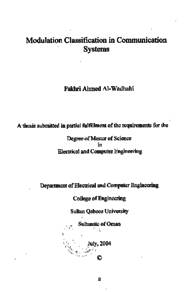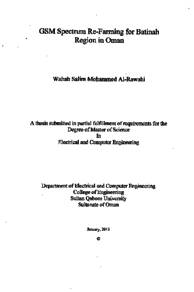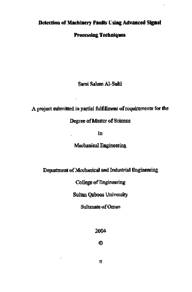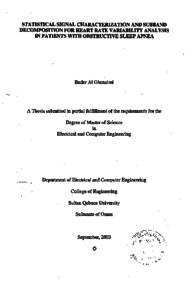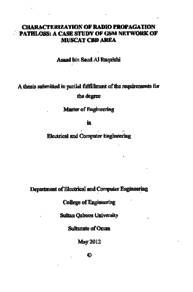وثيقة
.Modulation classification in communication systems
الناشر
جامعة السلطان قابوس
ميلادي
2004
اللغة
الأنجليزية
الملخص الإنجليزي
Automatic classification of the modulation type of an unknown signal has an important role in communication systems, especially in civilian purposes and in communication intelligence and military applications, to extract useful information from the signal. It has emerged in the research of communication systems, particularly in the study of software radio, due to the advances in reconfigurable signal processing systems. It is necessary for a multipurpose receiver to automatic choose among modulation types, in the presence of noise, in order to extract the features from the signal without distorting the signal in a manner that would affect the information that may be of interest and this is indeed a difficult process. A wide variety of techniques and approaches, for determining the modulation type applied on the signal, have been cited in the literature and this research will address the problem of automatic modulation recognition of analogue and digital communication signal using three methods i.e. Statistical Signal Characterization (SSC), Entropy of the Continuous Wavelet
Transform (CWT), and Linear Predictive Coding (LPC) of the CWT. The first technique is a new method and it uses the SSC idea to classify the different modulations of the signal. It extracts four different parameters from a certain modulated signal and compares these parameters to those of other different modulated signal. This provides a basis for the classification system proposed in this work. Artificial Neural Network (ANN) was used, with the four SSC parameters, to classify the modulation type of the input signal. This robust classification system can identify the modulation types with a low Signal to Noise Ratio (SNR) of 6 dB with an efficiency of 98% and 97% for analogue and digital modulations respectively and at 3 dB with an efficiency of 83% and 86.6%. The other two methods mentioned above for modulation classification have been reported in the literature and this research is reporting an extension work on them to identify more modulation types. Continuous Wavelet Transformation (CWT) was employed in these two methods with different wavelets to retain the time variable information in the signal, which is very important in the classification. The two methods were combined to form a hybrid system or multiple network classifier that was compared with Azzoz and Nandi [4] hybrid classifier system. It can identify the modulation type with SNR down to 6 dB with an efficiency of 90% and 95% for analogue and digital modulations respectively. A modulation level classifier is also proposed in this work to classify level 2 from level 4 of 4 digital modulations. The input to the designed systems is either analogue or digital signals, or combination of both. There are five analogue and three digital modulations were used for identification by the three methods. Finally, the methods were compared together regarding to some different parameters. The SSC technique is simple and shows best results at lower SNR compared to the other two methods.
المجموعة
URL المصدر
الملخص العربي
أن معرفة أو تصنیف انواع التضمين في نظم الاتصالات له دور كبير وفعال في التطبيقات المدنية والعسكريه وذلك لاستخلاص المعلومات والبيانات المهمة من الاشارات، بالرغم من وجود الضوضاء عليها، بطرق تضمن عدم المساس أو الحاق الضرر بالمعلومات المحتواه في الاشارات.
لقد طرحت طرق وافكار عده لمعرفة نوع التضمين المستخدم في الإشارة المستلمة في بحوث علمية حديثه وهذا البحث يدرس بتفصيل ثلاث طرق مهمة وهي:
- طريقة الصفات الإحصائية للاشارة (SSC). 2- طريقه إل Entropy المعتمده على (CWT). 3. طريقه إلى ''(Linear Predictive Coding
( LPC " المعتمده على (CWT).
أن طريقه إلى SSC " تعتبر من الطرق الحديثة التي تستخدم لتحليل الاشارات التي تعرض في هذا البحث لأول مره في مجال تصنيف اشارات التضمين حيث أن فكرتها الأساسية هي استخلاص اربعة خصائص من الاشاره ليتم استخدامها في معرفة نوع التضمين المستخدم في الاشاره ولجعل هذه الطريقه اكثر فعالية وقوه تم استخدام الشبكات العصبية الاصطناعية »ANN" حيث وصلت نسبة الكفاءه لمعرفة نوع التضمين بالنسبه للاشارات التناظريه الى (98%) أما بالنسبه للاشارات الرقمية فوصلت النسبة الى (96%) عند نسبه اشارة الى ضوضاء (SNR) مقدارها (dB 6) في الحالتين.
الطريقتان الثانية والثالثة المذكورة اعلاه تعتبر كذلك من الطرق الحديثه ، حيث تم ذكرها في بعض المنشوارت العلمية عام 2000 وهذا البحث يدرس هاتين الطريقتين بتمعن ويدخل أضافات جديده عليهما، منها زياده عدد انواع التضمين المراد معرفته بواسطتيهما وكذلك استخدام انواع اخرى من المويجات (Wavelets) وذلك للوصول إلى معرفة نوع التضمين المستخدم في الإشارة بنسبة اشارة الى ضوضاء أقل من السابق.
اثبتت النتائج بأن طريقه ال "Entropy" كانت تعطي نتائج جيده جدا لمعرفة نوع التضمين بالنسبه للاشارات التناظريه بكفاءة تصنيف تقارب (88%) عند (SNR) مقدارها (dB 6) بعكس الطريقه الثالثه (LPC) التي كانت تعطي نتائج افضل للاشارات الرقمية بكفاءه تصنيف تقارب (85%) عند (SNR) مقدارها (dB 6).
تمت مقارنة هذه الطرق الثلاثه مع بعضها البعض لمرفه مزايا كل واحدة عن الأخرى في نهاية هذا البحث وتبين أن طريقه إلى (SSC) هي الأفضل حيث كانت نسبة الكفاءة لمعرفة نوع التضمين بالنسبه للاشارات التناظريه 83% أما الإشارات الرقميه فوصلت النسبة إلى 87% عند (SNR) مقدارها(dB 3).
تم كذلك في هذا البحث اقتراح نظامين هجينيين يعتمدان على اكثر من طريقه لمعرفة نوع التضمين وتم الحصول على نتائج ممتازه حيث وصلت كفاءة التصنيف الى (90%) و (95%) بالنسبه للاشارات التناظريه والرقميه على التوالى.
قورن هذان النظامان بالنظام المقترح في المرجع (5) [1998 , Azzoz & Nandi ] حيث كانا الأفضل من حيث انهما يحتاجان فقط إلى خاصيه واحده من الاشاره لمعرفة نوع التضمين المستخدم فيها بينما يحتاج النظام في (5) الى و خصائص من الاشاره وهذا بدوره يبين مدى تعقيد هذا النظام بالمقارنة مع النظام المقترح في هذا البحث.
تم كذلك في هذا البحث اقتراح نظام تصنيف عدد المستويات في أنظمة التضمين الرقمية والذي يتم من خلاله تصنيف او معرفة المستوى الثاني من المستوى الرابع بالنسبة لأربعة أنواع من التضمين الرقمي هي:۔
ASK , FSK , PSK , MSKJ ] بكفاءة تصنيف تصل الى (95%) عند (SNR) مقدارها (dB 3).
لقد طرحت طرق وافكار عده لمعرفة نوع التضمين المستخدم في الإشارة المستلمة في بحوث علمية حديثه وهذا البحث يدرس بتفصيل ثلاث طرق مهمة وهي:
- طريقة الصفات الإحصائية للاشارة (SSC). 2- طريقه إل Entropy المعتمده على (CWT). 3. طريقه إلى ''(Linear Predictive Coding
( LPC " المعتمده على (CWT).
أن طريقه إلى SSC " تعتبر من الطرق الحديثة التي تستخدم لتحليل الاشارات التي تعرض في هذا البحث لأول مره في مجال تصنيف اشارات التضمين حيث أن فكرتها الأساسية هي استخلاص اربعة خصائص من الاشاره ليتم استخدامها في معرفة نوع التضمين المستخدم في الاشاره ولجعل هذه الطريقه اكثر فعالية وقوه تم استخدام الشبكات العصبية الاصطناعية »ANN" حيث وصلت نسبة الكفاءه لمعرفة نوع التضمين بالنسبه للاشارات التناظريه الى (98%) أما بالنسبه للاشارات الرقمية فوصلت النسبة الى (96%) عند نسبه اشارة الى ضوضاء (SNR) مقدارها (dB 6) في الحالتين.
الطريقتان الثانية والثالثة المذكورة اعلاه تعتبر كذلك من الطرق الحديثه ، حيث تم ذكرها في بعض المنشوارت العلمية عام 2000 وهذا البحث يدرس هاتين الطريقتين بتمعن ويدخل أضافات جديده عليهما، منها زياده عدد انواع التضمين المراد معرفته بواسطتيهما وكذلك استخدام انواع اخرى من المويجات (Wavelets) وذلك للوصول إلى معرفة نوع التضمين المستخدم في الإشارة بنسبة اشارة الى ضوضاء أقل من السابق.
اثبتت النتائج بأن طريقه ال "Entropy" كانت تعطي نتائج جيده جدا لمعرفة نوع التضمين بالنسبه للاشارات التناظريه بكفاءة تصنيف تقارب (88%) عند (SNR) مقدارها (dB 6) بعكس الطريقه الثالثه (LPC) التي كانت تعطي نتائج افضل للاشارات الرقمية بكفاءه تصنيف تقارب (85%) عند (SNR) مقدارها (dB 6).
تمت مقارنة هذه الطرق الثلاثه مع بعضها البعض لمرفه مزايا كل واحدة عن الأخرى في نهاية هذا البحث وتبين أن طريقه إلى (SSC) هي الأفضل حيث كانت نسبة الكفاءة لمعرفة نوع التضمين بالنسبه للاشارات التناظريه 83% أما الإشارات الرقميه فوصلت النسبة إلى 87% عند (SNR) مقدارها(dB 3).
تم كذلك في هذا البحث اقتراح نظامين هجينيين يعتمدان على اكثر من طريقه لمعرفة نوع التضمين وتم الحصول على نتائج ممتازه حيث وصلت كفاءة التصنيف الى (90%) و (95%) بالنسبه للاشارات التناظريه والرقميه على التوالى.
قورن هذان النظامان بالنظام المقترح في المرجع (5) [1998 , Azzoz & Nandi ] حيث كانا الأفضل من حيث انهما يحتاجان فقط إلى خاصيه واحده من الاشاره لمعرفة نوع التضمين المستخدم فيها بينما يحتاج النظام في (5) الى و خصائص من الاشاره وهذا بدوره يبين مدى تعقيد هذا النظام بالمقارنة مع النظام المقترح في هذا البحث.
تم كذلك في هذا البحث اقتراح نظام تصنيف عدد المستويات في أنظمة التضمين الرقمية والذي يتم من خلاله تصنيف او معرفة المستوى الثاني من المستوى الرابع بالنسبة لأربعة أنواع من التضمين الرقمي هي:۔
ASK , FSK , PSK , MSKJ ] بكفاءة تصنيف تصل الى (95%) عند (SNR) مقدارها (dB 3).
قالب العنصر
الرسائل والأطروحات الجامعية

